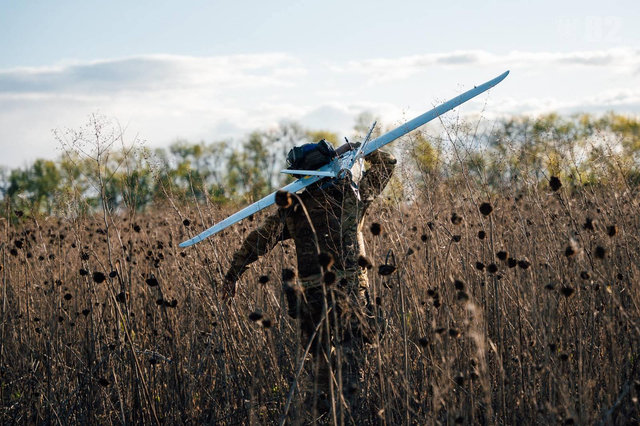
A huge part of Ukraine’s courageous and resilient stand against aggressor Russia in the past two years of a war now in its fourth year has been successfully utilizing its drone warfare. The use of unmanned aerial vehicles in the military has advanced exponentially since Russia’s full-scale invasion of Ukraine in February 2022. Many now refer to the current conflict as the world’s first-ever full-scale drone war. As Vladimir Putin’s “special operation” enters its fourth summer, reports indicate that drones account for some 70 percent of total Ukrainian and Russian battlefield fatalities.
As Russia’s current summer offensive pushes on along active frontlines some 750 miles long according to General Oleksandr Syrsky, Ukraine’s over-extended military is in a position of heavy reliance on drones to thwart any major Russian advances. Ukraine’s state-of-the-art and fast-paced use of unmanned aerial vehicles as a layered defensive shield has been labeled a “drone wall.” If Ukraine’s “drone wall” can sustain itself over the next several months and stymie Putin’s big offensive, it could very well configure future defensive axioms in military institutions across Europe and the world.
JOIN US ON TELEGRAM
Follow our coverage of the war on the @Kyivpost_official.
Ukraine’s drone strategies happened out of military prerequisites and are a segment of a far wider shift toward the supremacy of unmanned systems on today’s battlefield. After Russian forces were victorious in the battle of Avdiivka in early 2024, Ukraine was in a defensive position while facing drastic shortages of artillery caused by delays in receiving promised aid from the United States. Kyiv was forced to turn to drones as an inexpensive and practical substitute for more traditional ammunition.
Other Topics of Interest
Russian Su-27UB Fighter Jet Destroyed in Krasnodar Krai, Ukraine’s Intel Releases Video
A Russian Su-27UB combat training jet was destroyed at Armavir airfield in Krasnodar Krai.
Although drones cannot completely replace artillery’s firepower, Ukraine’s usage of drones to establish defensive passageways many miles deep has proven to be extremely successful. Drones are used to conduct air attacks and for surveillance purposes, making it very challenging for Russia’s forces to concentrate and launch large-scale offensive operations. The positive effects of this strategy can be seen in the large degree of damage being done to Putin’s invading army. Strategic study institutes in Europe estimated that in 2024 Russia lost some 1,400 tanks and more than 3,700 armored vehicles.
While Ukraine’s drone wall has gained form in the last 18 months, Russian military leaders have been forced into altering their approach. Small infantry units hoping to achieve local advances have replaced large armored battalions looking to fight through Ukrainian defenses. Smaller and more mobile forms of transport like motorcycles and buggies are being used in lieu of clumsy armored vehicles to evade Ukrainian drones.
The success of the Ukrainian drone wall depends on increased quantities, continued advances in technology, and a merging into existing military structures.
Russia is replicating Ukraine’s success in drone warfare with the two nations competing daily to obtain an advantage on the battlefield through ongoing innovation. Currently the Russians seem to have an edge through their large-scale manufacturing and distribution of drones operated by fiber-optic cables. Such a low-tech type of drone has been called a game changer because these models cannot be jammed by existing electronic warfare devices.
In the interim, Russia is targeting Ukrainian drone operators and the radar stations they rely on. This challenges Ukraine to maintain its extensive drone coverage comprehensively along the war’s frontlines.
The success of the Ukrainian drone wall depends on increased quantities, continued advances in technology, and a merging into existing military structures. Domestic Ukrainian drone production is booming in the last couple of years with hundreds of companies entering the market. Expected output in 2025 is some four million drones as per Ukrainian Defense Minister Rustem Umerov.
Progress notwithstanding, Ukraine’s drone manufacturing is impeded by financial restraints. At a recent NATO summit President Volodymyr Zelensky said his country could produce eight million drones a year with proper funding. He posed the argument that this shortfall in funds was a priority for both Ukraine and the future security of Europe.
In an effort to better integrate drone units into the Ukrainian armed forces, the country has established a new division of the military devoted to drone warfare. The Unmanned Systems Forces branch is spearheading attempts to upgrade the drone wall while improving other areas of the country’s drone operations. Earlier this spring Ukraine launched the Drone Line enterprise, which has a goal of building on the experience of the Ukrainian military’s top drone units and grow the drone wall concept to establish a “kill zone” with a depth of up to 10 miles.
Ukraine’s inventive utilization of drones to delay Russian advances is drawing the attention of Kyiv’s European allies. In April, Germany and several other NATO members announced their plans for a drone wall initiative, stretching on the association’s eastern flank from Norway in the north down to Poland. The objective is to discourage Russia with a combination of AI-powered reconnaissance and anti-drone systems.
In the meantime, England and Ukraine agreed to a joint venture to produce Ukrainian-designed drones financed by the UK government. This agreement underlines the growing recognition among Kyiv’s European partners that Ukraine has graduated from being merely a beneficiary of military assistance, but has become a valued security ally having experienced some unique modern warfare. It has also been reported that British troops are being trained by Ukrainians specializing in drone warfare.
Of course the Ukrainian drone wall by itself will not stop the invading Russians. However, with enough funding, successful coordination and adequate support from more standard armament systems, there are solid grounds to conclude that this path can make it very difficult for the Russian army to attain significant battlefield advances. A supreme test is forthcoming in an intense summer offensive as Putin intensifies pressure on his commanders to achieve results no matter the cost. Should Ukraine’s SUAVE defense plan assert itself, Kyiv’s drone wall will gain recognition as a key component in Europe’s future defense against Russia.
The views expressed in this opinion article are the author’s and not necessarily those of Kyiv Post.





